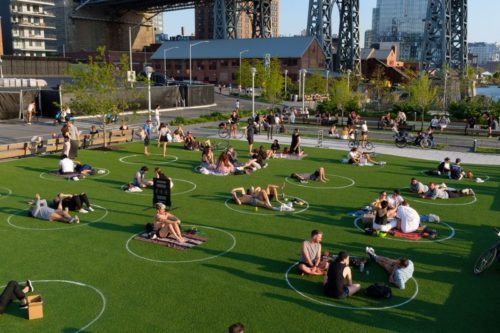
Build new parks where they're needed most
July 27, 2020
By Carter Strickland and Adam Ganser
To keep New Yorkers safe during the COVID-19 pandemic, earlier this year, outdoor spaces including playgrounds and ball fields near over one million New Yorkers were closed. This loss of access was disproportionately concentrated in Central Brooklyn, Queens, and the East Bronx, including in many of the neighborhoods where the largest proportion of people have died or become seriously ill.
These closures revealed underlying inequities in the availability of open space. Rebuilding a stronger city will require we strengthen park resiliency just as we retrofitted our built environment after 9/11 and Hurricane Sandy.
New York has more parks compared to peer cities. The city manages more than 1,700 parks, and when combined with playgrounds managed by the Department of Education and parks managed by the federal and state government, there are more than 2,300 open spaces in the city.
That network means when every park and playground is open, 99% of New Yorkers live within a 10-minute walk of a park. However, the median size of New York parks is only 1.1 acres, a fifth of the median size of parks in the largest 100 cities. These parks have to accommodate a population density that is orders of magnitude higher than any other city in the country.
The coronavirus crisis revealed the inequitable structure of our system. First, the closure of playgrounds, basketball courts, turf fields, recreational centers and dog parks showed many of our lowest-income neighborhoods are dependent on just one facility, often a non-traditional, single-purpose open space.
According to data from The Trust for Public Land, with COVID-related closures, park access within a 10-minute walk dropped to 86%, meaning more than a million New Yorkers in central Brooklyn, Queens and the East Bronx lost the ability to get outside. Those closures did not affect wealthier neighborhoods.
Second, the parks remaining open were even more space-constrained than usual, as visitors were required to spread out. Our analysis shows in NYC, parks within a 10-minute walk of a majority of low-income households are less than half as big as parks within a 10-minute walk of high-income households (on average 6.4 acres compared to 14 acres). Correspondingly, parks serving low-income communities serve more people per acre.
Until all neighborhoods have a park that can stay open during a crisis, the inequities in our system will persist. Recent efforts have focused on rehabilitating existing parks that have not seen upgrades in more than 20 years, a much-needed corrective. But it is not enough to just fix up our inherited park system. Wonderful new parks like Brooklyn Bridge Park, Domino Park, and Hunter’s Point South Park show we are still capable of building new parks — but our efforts can’t be limited to wealthy neighborhoods as part of a redevelopment project.
We need a New Deal for Parks that would bring critical infrastructure to neighborhoods that are home to a broad swath of New Yorkers of color. Just as was envisioned in the Great Depression, when the city built Orchard Beach, opened 11 new pools in 11 weeks, and built many of the parks that benefit us today, the city must develop a vision for new parks so that we are ready for an influx of park-related funding. Finding land for new parks is challenging but not impossible, as the city has done when it has repurposed existing infrastructure and waterfronts, and built city garages, schools, substations, transit, and other critical new infrastructure.
Just last week, Congress passed legislation to fund parks and open space by permanently reauthorizing and funding the Land and Water Conservation Fund at $900 million. Both the infrastructure and transportation bills, when they eventually happen, must provide opportunities for park funding in NYC and beyond. Additionally, The Trust for Public Land is part of a coalition pushing for a one-time investment of $500 million for urban parks, as part of coronavirus stimulus legislation.
Let’s make New York stronger with new parks.
Strickland is New York State Director for The Trust for Public Land. Ganser is executive director of New Yorkers for Parks.